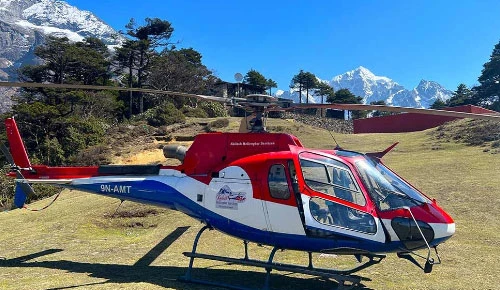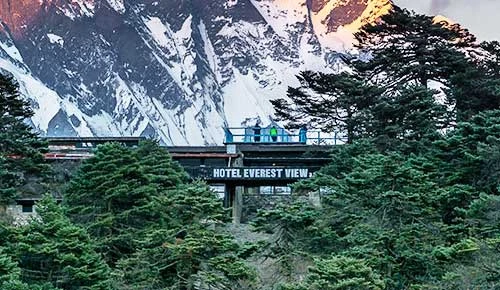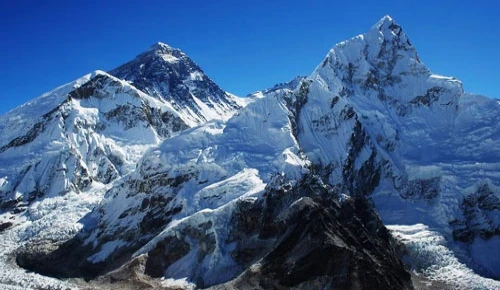Weather in the Annapurna Region
Planning on going on a trekking journey to the Annapurna region? If yes, then this blog is exactly what you were looking for.
Trekking in the Annapurna region is an experience of a lifetime. To ensure that you have a comfortable and safe adventure in the Himalayas, knowledge about that Himalayan region plays a crucial role.
This blog explores the weather of the majestic Annapurna region. This blog will help you prepare for your treks in this region. Let’s dive into the enigmatic weather of the Annapurna region.
Weather in the Majestic Himalaya
Adventurers from all over the world are drawn to Nepal's Annapurna region because of its trekking paths, varied flora and wildlife, and stunning scenery.
The ever-changing weather, however, is a factor that profoundly affects the experience of trekkers amongst the breathtaking splendor of this Himalayan paradise.
Tucked away in the majesty of the Annapurna range, home to some of the highest peaks on Earth, the local weather is as diverse as the topography.
The Annapurna region presents a rollercoaster of climatic events that could test even the most experienced of travelers, from clear skies and bright sunshine to unexpected snowstorms and heavy rains.
The varied geography of the region is one of the main elements affecting the weather. There are many different types of terrain, each with its own microclimate, from verdant lowlands to untamed mountain passes.
Trekkers can witness sudden shifts in temperature, precipitation, and wind patterns over short distances when they rise or descend along the routes.
Table of Contents
Seasons and their Stories
There are four different seasons in the Annapurna region of Nepal, each with its own unique features for tourists. Let's examine every season in further detail:
Spring Season
After the chilly winter months, springtime in the Annapurna area is a magnificent period when nature comes alive. This season, which runs from March to May, is when Nepal's national flower, rhododendrons, bloom. The plants' vibrant red, pink, and white blooms cover the slopes. Trekking in the Annapurna Conservation Area in the springtime is like walking through a floral wonderland, with bright flowers along the paths and an abundance of lush vegetation covering the surroundings.
One of the best seasons for trekking in the Annapurna region is spring, when the weather is usually pleasant and consistent.
Uninterrupted panoramas of the snow-capped peaks, such as the magnificent Dhaulagiri, Machapuchare (Fishtail), and Annapurna massif, will be seen under clear skies.
At every bend, trekkers are rewarded with expansive views of majestic mountains mirrored in glistening lakes and mountain streams, producing picture-perfect scenes.
Trekking becomes enjoyable as the weather gets more suitable during the day, providing ideal hiking conditions for exploring the varied landscape.
Every day offers fresh settings to explore and discoveries to be made, from terraced farms and charming towns to alpine meadows and rhododendron woods.
In this region, spring also marks the start of the trekking season, drawing travelers from all over the world who are eager to set out on their Himalayan adventure.
With the backdrop of stunning mountain views, tea houses and lodges along the routes come to life as both locals and travelers gather around cozy fireplaces to exchange narratives and experiences.
Temperature overview of spring season
Month | Day Temperature (°C) | Night Temperature (°C) | Sunshine Hours (Daily) | Humidity | Wind Speed |
March | 10°C to 12°C | 4°C to (-8°C) | 7-8 hours | Low | Relatively Low |
April | 15°C to 20°C | 8°C to (-4°C) | 7-8 hours | Low | Relatively Low |
May | 17°C to 25°C | 0°C to 5°C | 7-8 hours | Low | Relatively Low |
Summer Season
In the Annapurna region, summer, which lasts from June to August, marks the arrival of the monsoon season and a significant change in the surrounding environment.
The environment is painted with a range of greens as the monsoon rains nourish the vegetation, making the formerly lush and verdant slopes even more vivid. But in addition to this wealth of nature, summertime poses some difficulties for travelers to the area.
The intense rainfall throughout the summer months in the region is one of its distinguishing features. Strong and continuous monsoon rainfall can clog trekking paths with mud, making it challenging to navigate.
Along the journey, trekkers might face landslides or flooded rivers, so they should be ready for slippery and perhaps risky situations.
Although there might be occasional cloud gaps that provide views of the magnificent mountains, trekkers should lower their expectations for visibility in the summer. Rather, the emphasis turns to savoring the verdant vistas and tumbling waterfalls that bloom as a result of the precipitation.
Although the monsoon season presents certain difficulties, summer in the Annapurna region is not without its benefits.
The landscape is in full bloom, with rhododendrons giving colorful bursts to the verdant foliage and wildflowers covering the slopes.
Since fewer people arrive during the monsoon season than during the busiest trekking seasons, those who don't mind getting a bit wet may find themselves in a more serene and private setting.
Trekking in the summer can be beneficial for intrepid tourists who are ready to brave the weather, but it also demands careful planning and flexibility.
Temperature overview of summer season
Month | Daytime Temperature (°C) | Nighttime Temperature (°C) | Sunshine Hours | Humidity | Wind Speed | ||
June | 10°C to 17°C | 6°C to (-4°C) | 5-6 hours | High | Moderate to Strong (increases with altitude) | ||
July | 10°C to 12°C | 4°C to (-5°C) | 5-6 hours | High | Moderate to Strong (increases with altitude) | ||
August | 10°C to 20°C | 8°C to (-3°C) | 5-6 hours | High | Moderate to Strong (increases with altitude) | ||
Autumn Season
Trekkers can have a very enthralling experience in the Annapurna region during the wonderful autumn season, when the scenery changes into various colors.
Thanks to its consistent weather and bright skies, the September–November season is considered one of the best times to visit the area.
Autumn brings brilliant shades of green, gold, and crimson to the hillsides, revitalizing them as the monsoon rains gradually fade.
The superb view of the snow-capped peaks is one of the best things about fall in the Annapurna region. For the most part of the season, trekkers are blessed with bright skies and expansive vistas of majestic mountains like Dhaulagiri, Machapuchare, and Annapurna I.
Autumn is a great time to go hiking because of the typically moderate and pleasant weather.
Trekkers can trek for hours during the day without feeling too hot, while at lower elevations, the nights can be chilly but not too cold.
Travelers can discover cultural joys in the fall in addition to the beauty of nature.
During this season, the region's ethnic communities, such as the Gurungs, Thakalis, and Manangis, celebrate a number of festivals and cultural events, giving guests a chance to fully immerse themselves in the warm hospitality and rich traditions of the locals.
Temperature overview of autumn season
Month | Daytime Temperature (°C) | Nighttime Temperature (°C) | Sunshine Hours | Humidity | Wind Speed |
September | 10 °C to 15 °C | 5 °C to (-7 °C) | 7 hours | Relatively Low | Relatively Low |
October | 10 °C to 17 °C | 4 °C to (-5 °C) | 7 hours | Relatively Low | Relatively Low |
November | 10 °C to 12 °C | 5 °C to (-10 °C) | 7 hours | Relatively Low | Relatively Low |
Winter Season
The Annapurna region experiences a remarkable transformation throughout the winter, which lasts from December to February.
Snow covers the landscape, providing a quiet and otherworldly ambiance. This time of year, when temperatures drop, especially at higher elevations, the area takes on a serene beauty that is all its own.
In this region, winter brings cold temperatures and occasional precipitation, especially in the higher Himalayan regions.
Trekkers who endure the cold can see beautiful panoramas as the snow-capped peaks, including Dhaulagiri, Machapuchare, and Annapurna I, make a stunning background against the pure blue skies.
Wintertime access to lower-altitude paths might be maintained, while higher passes and trekking routes, like Thorong La, might be closed or difficult to go through because of snow accumulation.
In order to guarantee their safety and comfort, trekkers must be properly outfitted for the cold weather, including insulated jackets, gloves, and strong boots.
Even though the winter months might be difficult, they provide a special and captivating hiking experience in the Annapurna region.
In comparison to the busiest travel seasons in the spring and fall, the trails are frequently calmer and have fewer visitors, enabling a closer encounter with the surrounding environment.
There are many benefits for individuals who trek into the Annapurna region in the winter. There is nothing like the enchanted atmosphere that the snow-covered terrain, frozen waterfalls, and glistening mountain streams provide at this time of year.
While trekking in the unspoiled wilderness, visitors could come across local villages going about their everyday lives in front of snow-capped peaks, providing a window into the tenacious spirit of the people who live in this area.
Trekkers may spend the evenings in quaint tea houses around crackling fires, enjoying delicious meals, and exchanging tales with other intrepid travelers.
Temperature overview of winter season
Month | Day Temperature (°C) | Night Temperature (°C) | Sunshine Hours | Humidity | Wind Speed | ||
December | 5 °C to 10 °C | 0 °C to (-25 °C) | 6-7 | Low | Moderate to Strong (increases with elevation) | ||
January | 7 °C to 10 °C | 0 °C to (-15 °C) | 6-7 | Low | Moderate to Strong (increases with elevation) | ||
February | 7°C to 12 °C | 0 °C to (-15 °C) | 6-7 | Low | Moderate to Strong (increases with elevation) | ||
Finding the Perfect Season: Best Season to Trek to Annapurna Region
The best seasons for trekking in the Annapurna region are the spring and autumn seasons. Let’s look at the summary of these seasons.
Season | Months | Temperature Range (°C) | Highlights | Best for |
Spring | March-May | 10-20 (days), 0-5 (nights) | Blooming wildflowers, clear skies, and potential snow at high altitudes | Pleasant trekking and scenic views |
Autumn | September-November | 5-20 (days), -5-5 (nights) | Clear skies, minimal precipitation, and stunning panoramas | Ideal trekking season |
Essential Tips for Navigating Annapurna Region Weather
- Layer up and bring as many sets of clothes as possible so you can adapt to fluctuations in temperature throughout the day.
- Invest in water-resistant apparel and equipment to ensure your safety during unexpected downpours.
- Examine the weather forecasts. Before starting a trip, keep up with weather forecasts to be ready for any changes in the weather.
- Drink plenty of water, especially at higher elevations where it might happen more quickly due to dehydration.
- Wearing sunscreen, sunglasses, and a hat will help shield you from the powerful UV rays that are present at high elevations. Sun protection is essential.
- Emergency supplies: In case of unforeseen weather delays, keep emergency supplies on hand, such as a first aid kit, flashlight, and extra food.
- In regards to weather and hiking safety, respect local expertise and pay attention to local guides.
Embrace Nature’s Tapestry
In conclusion, exploring the weather in the Annapurna region reveals a dynamic and constantly shifting terrain that enhances the trekking experience's thrill and difficulty.
Every season presents different challenges and opportunities for travelers, from the pristine sky and blossoming rhododendrons of spring to the peaceful, snow-covered landscape of winter.
The Annapurna region continues to captivate tourists from all over the world who come to see the breathtaking grandeur of the Himalayas, despite the unpredictable weather.
Every journey through this enchanted region, whether it is through mist-shrouded valleys or marveling at snow-capped summits, is a monument to the beauty and force of nature.
In the end, the Annapurna region is a genuinely unforgettable destination for outdoor enthusiasts and environment lovers alike, since it's not just about getting there but also about loving the journey with all of its twists and turns.








